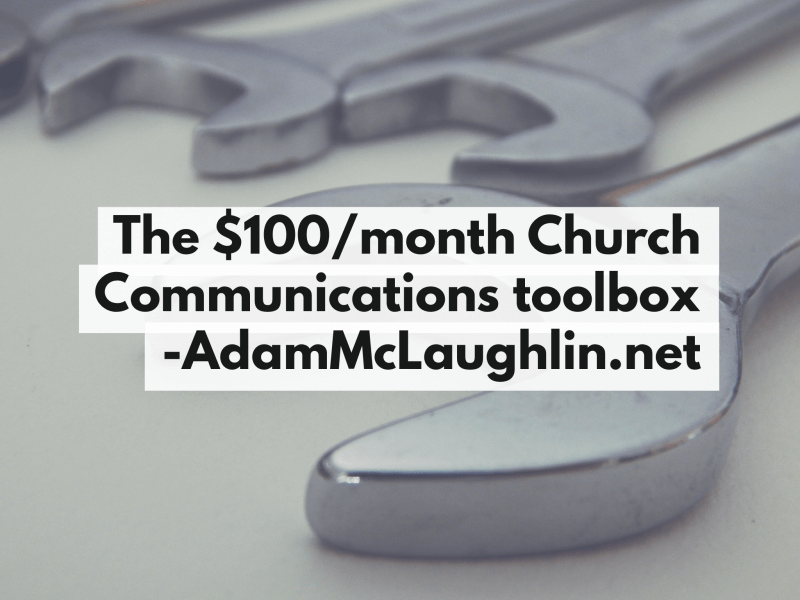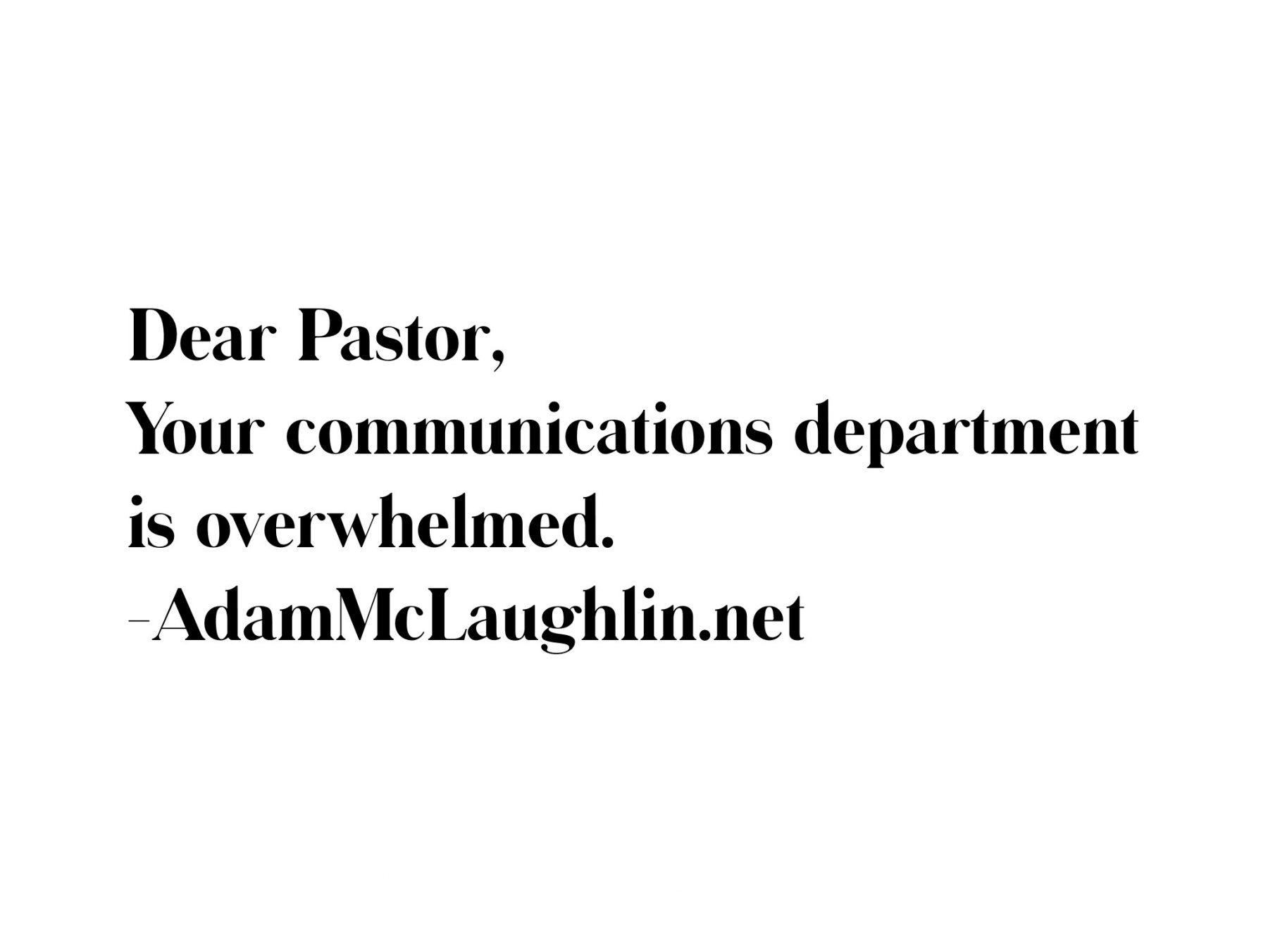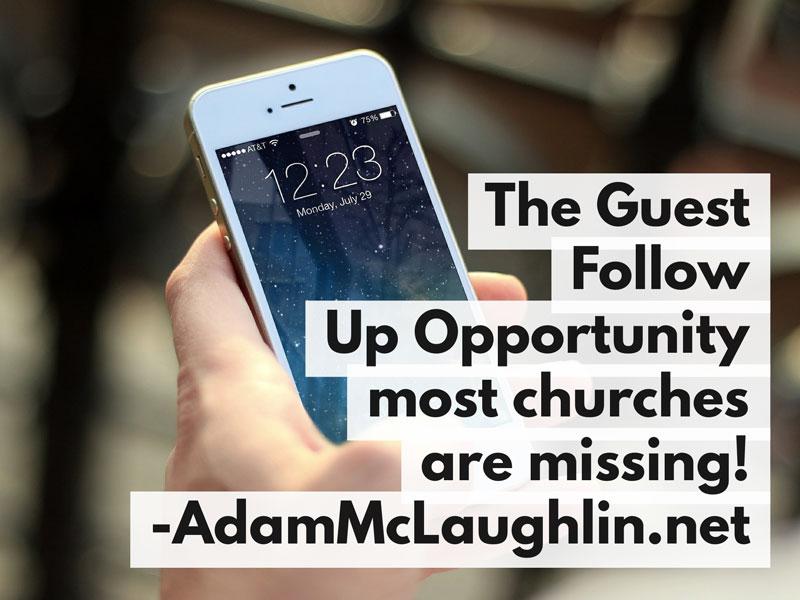Dear Pastor,
Whether your key communications and marketing person is staff or volunteer, you’ve probably run into hearing that he or she is overwhelmed from time to time.

(I also wrote this blog post to help Communications Teams avoid using “overwhelm” as an excuse.)
There are some strategies that you can implement to help them address feeling overwhelmed and reduce the likeliness of it recurring.
My goal is not to defend or justify laziness, disorganization or an entitlement mentality. My goal is to give you a peek into our world – a world we can’t always articulate – with some practical tools to help so your communications department can reduce the likelihood of being overwhelmed and be as effective as possible in helping your church introduce your community to Jesus.
My hope is that this article will help start conversations between communications teams and their leaders. If you need help having what may seem like a difficult conversation, I would recommend reading the 5 dysfunctions of a team by Patrick Lencioni, and Leadership and Self-Deception by the Arbinger Institute.
Why is feeling ‘Overwhelmed’ affecting your church communications department?
Before we dig into strategies to mitigate and address overwhelming situations, I wanted to dig in a bit about why they affect the communications department specifically. I know these details are different for every church, community, and culture, but generally speaking, here are some of the ideas that affect most churches.
Consideration 1) Vertical: The Communication Leader is Middle Management
The communications department is somewhere in middle management in the organization’s structure. Usually, the communications person is not the lead Pastor, and often they have someone working under them that they oversee – whether this is a graphic design contractor like Church Media Squad, or working with external software and teams like Text In Church, or a volunteer team on-site at your church.
While not making the decision, or sometimes getting input into decisions, the Church Communications person represents the decision as if it’s their own and communicates on behalf of the leadership and the church (internally or externally).
This can be taxing when we have an idea of how to best communicate something, which channel to use, or how to position an announcement, but we’re considered robots – following directions about how, when and where from someone who may not understand our tools – rather than considering us creative people who specialize understanding our tools and presenting ideas in a unique way.
Consideration 2) Horizontal: We primarily serve other departments.
Some leaders are in a solely-focussed role, while other leaders who are wearing a few hats may have to work in 2 or 3 categories. Your communications person needs to have their ears to the ground in almost every category, event and department at your church.
For example, the youth leader has a full plate getting youth services ready, preparing games, food, missions trips, weekends away, counseling students, communicating with parents and executing midweek services or small groups. While the responsibilities are diverse, all of those items fall in the category of the youth department.
A week in a communication person’s world may look like:
- When is VBS?
- How many new small groups are we adding this year?
- What is our Social Media strategy leading up to Back to School / Back to Church?
- Did the printer quit partway through printing the bulletins?
- What are we including in announcements this weekend?
- Did we get that email sent out about the food drive coming up this weekend?
- Where did last week’s volunteer photographer leave the battery when they were done?
- Is it time for us to rebuild the website? Kids ministry pictures are outdated.
- Should our church get an app?
- Oh, there’s a text message from the 70’s and over married couples skydiving small group asking why they aren’t getting an announcement during service this weekend!
- Why aren’t we getting as many new likes on facebook this month as we got last month?
- I need to get a quote from the printer on new banners for our parking lot.
- Which graphic would best suit the upcoming series?

- We’re announcing this but not that (one person is happy and another is not.)
- We only have one spot to hang a banner, so we’re hanging this banner up, but not that one (one department gets promoted, and another isn’t).
- We’re not going to promote small groups in that way (now a whole group of people is disappointed because they wanted their small group to get an announcement, bulletin mention, yard signs, billboard, radio ad, a personal Instagram video from Pastor, and a parade downtown are all upset that you “don’t value their group as much as they do”)
Consideration 3) How long does that really take?
In addition to having both Vertical and Horizontal responsibilities, our “to do” list is often misunderstood or misrepresented. The question of “How long does that really take?” is an important part of the ongoing conversation that you can have with your team.
With the perception that “Posting on facebook is as quick as sending a text message” or “Creating a 2-minute video is hitting record on your phone and recording for 2 minutes,” or “I write a 3 paragraph email in 10 minutes, so writing a 3 paragraph email newsletter should only take 10 minutes,” or “Just send the bulletin to the printer and pick it up when it’s done in an hour.” (I could go on…)
In light of those perceptions, the ACTUAL time it takes to craft a Facebook post, or shoot an announcement video or write an email newsletter may seem too long and can create a sense that the communications person is unproductive or needs more on their plate to fill their work hours.
Did it really take you 20 minutes to edit a photo and create a 1-sentence caption for Instagram? Did it really take a whole afternoon to film and edit a 4-minute announcement video? You’ve been working on that email newsletter for how long?!
Keep in mind that a 40-minute sermon may take you days to craft at times, and other times, could literally take only 40 minutes, and many care and counselling roles at churches are driven by meetings: a 1-hour meeting takes one hour. A 15-minute meeting takes 15 minutes. Surprises and overruns don’t happen often when you have back-to-back meetings – you can simply schedule another meeting if needed for a future date.
The same isn’t true when creativity and technology meet at a crossroads.
While we have tools that make us more efficient, creatives often use the tools to do better work, not faster work – we may use a tool that gives us a better final outcome, but it doesn’t necessarily mean we spend less time picking a color, or choosing our words, or adding in final touches to a video.
Consideration 4) How much energy does that take?
It’s not uncommon for a creative person to be exhausted by 2 pm or 3 pm.
Sometimes we’re night owls, so our best ideas (and best work) happen late at night. It’s possible we were up until 3 am night working on graphics for church this weekend, then at the office at 9 am the next day for a staff meeting.

Inversely, someone who is a night owl who has a flex-schedule may work until 2 am, get into the office at 11 am and have some of their most productive time mid-afternoon with a great project to show from the night before.
Being “less productive” from mid-afternoon until the end of the day isn’t always a symptom of laziness (although, let’s be clear that sometimes it may), but it may be a symptom that we’ve given our best for the organization at other times through the day, and we need to recharge.
Just because something took 1 hour this morning, doesn’t mean we can turn around and repeat it in 1 hour this afternoon.
Consider a creative day like a boxing match. A punch is a punch, but that doesn’t mean that round 5 has the same level of sustained energy as round 1.
I’ve heard from many Pastors that they are exhausted after preaching for an hour on Sunday. It would be ridiculous to assume that one hour of replying to emails on Monday might take the same energy as presenting a one hour message on Sunday. The same is true for someone who is spending their creative energy.
The same thing may be true early in the week compared to later in the week. It’s different for every person, but there has to be some flex built into the schedule for considerations about “How much energy does that take?”
Consideration 5) Our world is always changing.
…And I don’t mean that every few years a new channel shows up. What I mean is that what you see another church doing on Instagram may not be able to reproducible the next week, or what you see someone with a large following doing on facebook may be a feature that requires 100K or more ‘likes’ on their page, and you simply aren’t there.

You may not get the results you’re used to from one day to another, or your communications person might have built a strategy around a particular feature which is no longer accessible one week into a campaign.
A program they’re used to using could run an update and change the layout of the toolbar that takes them an extra half hour to get re-oriented, and Google may change what constitutes as “spam” email, and way fewer people may open the email this week compared to last week.
Unlike the worship team that turns on the same sound system each week or the kid’s team that has the same classroom space in your building, their world, tools (and the communication strategies/tools they use) are always a moving target.
Consideration 6) We execute with a strategy in mind.
While you may think that it’s only going to take a few minutes to publish a simple “last-minute” post on facebook, that may actually hurt your big-picture strategy.
In this example, Facebook wants to see engagement on each individual post to determine how often to share the next. If you had just posted on facebook a few minutes ago, it can actually hurt the impact of both posts by publishing too quickly again since there wasn’t much time for people to see and engage with the first post.

They love your church. They’re doing this because they love the community, your vision, and they want to communicate effectively. They’ve made decisions that lead to a certain result (and your team would probably love to have a conversation with you about that.)
I imagine that you wouldn’t randomly walk into a youth service and tell the youth leader to add in a new song that night or tell the kids teachers on a Sunday morning to change their lesson plan. A random “I need you to do this now” doesn’t reflect an appreciation for the strategy your communications person brings to the table.
Something more like “We need to communicate this urgently. How can we best do that?” shows that you trust what they’re doing and you’re trusting them to handle the details.
Consideration 7) Our work is on public display
Ask your communications person how many communications they get per month about a typo on the screens or a detail incorrect on a facebook post (that instead of commenting privately, the event co-ordinator decided to make a public comment on the post to correct the details). It’s not that your communications person is sloppy, but we’re human and mistakes happen – and ours are often public.
Worse than actual, identifiable mistakes, we also get to hear everyone’s opinion about “Why would you choose that background?” or “Can we do something a little more subtle?” or “I don’t like that font” – and often from people who are unrelated to the event being promoted.
I once had a gentleman come to me after church to tell me that he noticed a typo in someone’s name on the screen during a video I made for our building campaign. He said “If we’re raising that much money, it’s disappointing that we can’t even spell someone’s name correctly.” (this was only one of the three times the name appeared during the video.)
I asked if he would like to help and preview the videos like a “proof reader.” He said he wasn’t the one getting paid to be sure it was right, that’s my job.
Most departments may have an internal memo with a spelling error, or the youth leader has an off night during his message, or in a meeting, something is said that could have been worded differently.
Our work is getting mailed out to the community, posted on the front lawn, shared on facebook, seen on the screens, or hung in the lobby.
How would you handle it if every time you misspoke during a sermon, someone stood up and let you know like it was urgent?
A fire alarm is urgent. Misspeaking, having an unclear thought, mentioning one scripture reference but turning to another, or tripping over your words is not worth someone yelling “FIRE!”
I realize that you’ll often get a follow-up email from someone about your message, but even that person knows to distinguish between what they think is important (important enough to send an email) and urgent (like jumping up in the middle of church service).
How can you help reduce the feeling of being overwhelmed?
Consideration 1) Vertical: Middle Management.
Move towards giving your communications person a seat at the decision table and allow them to earn your trust. You don’t have to flippantly toss decisions to them or take their recommendation every time, but a simple “What do you think?” or “If this was your decision, what would you do?” along with hearing the rest of the discussion is going to be helpful in communicating the big picture.
Consideration 2) Horizontal: Serving other departments.
Equip your communications team with tools to help them be more efficient and give their best. Here is a toolbox of what I would consider essentials for less than $100/month.
With the help of that toolbox, you’ll equip your team do their best in tracking projects, create incoming request forms, and work with other departments in your church as efficiently as possible.
Delegate communications decisions to the Communications person, support them as the decision-maker, and bring them into a conversation if someone comes to you to request that you veto a decision.
Consideration 3) How long does that really take?

Come to an agreement on what is a reasonable expectation, and where time consumed on one project may not provide the best return compared to that same time spent elsewhere.
Be slow to assume that making a request is so simple that it can be easily fit into the workload instantly.
Build time into the schedule for your communications person to be creative, dream and explore new ideas. Stuffing every minute of their day is going to be exhausting, and you’ll get the same recurring results… which leads us to the next point.
Consideration 4) How much energy does that really take?

Push back against the tendency you may have to set office hours. When Sunday rolls around, do you want to present your best work or do you want to check the box that said someone was present at their desk from 9 am – 5 pm all week? Of course, nobody at your church cares how many hours a project took, or whether it was completed at 2 pm or 2 am.
What matters when all is said and done is the end result, not the schedule necessary to create the result.
This isn’t to say that your communications leader can miss morning meetings if they’re a night person, or miss afternoon meetings if they like to start earlier in the day. But if there’s nothing scheduled at 9 am, and they worked an extra 4 hours last night, what difference will it make on Sunday if they show up at the office at 9 am or not?
Earn the best from your communications person by having clear goals and helping them meet those goals in whatever time it takes.
Consideration 5) Our world is always changing.
Have regular conversations that start with “What strategy do you have in mind for this event?” or “How are you planning to promote this?” or “What have you seen others doing that could work here?” Understand that we can’t promise the same results since the tools we use are always changing, and those changes are outside of our control.
Avoid saying, “We’ve done it like this before. Do that again!” or “They’re doing it. Why can’t we?”
Instead, have conversations with your communications person that lean into their wisdom, experience, and hands-on knowledge of the tools they have available to them. Ask questions that start with “What would you suggest for…?”
We’ll never get away from changing social media tools, but you can reduce the stress that keeping up with those details can cause by giving us some freedom to try new things, and explore. Recognize that at any time, the answer might be “That’s not how it works any longer.”
Consideration 6) We execute with a strategy in mind.

The same goes for what we plan to include in announcements, (or how many announcements), what we post on facebook, twitter or Instagram, how we’ll send out text messages or our email newsletter.
By all means, have conversations with your communications person about their decisions, their strategy, pick their brain about what and why, and be clear about what you’re hoping to achieve so they can help your church get to that end goal…
…AND, remember that this is our life and focus. We don’t take the responsibility lightly, and we’re not (usually) trying to be flippant or lazy or territorial if we say that your suggestion about how we communicate something may have some better options.
Consideration 7) Our work is public.
Learn to distinguish the difference between important and urgent. Important means “That’s worth noting and talking about later so that we try to avoid that mistake next time.” Urgent means “This needs to be addressed now.”
When you walk up on stage after an announcement video and make a joke about a typo on the screen, or send off a text message about the bulletin when it’s already printed and can’t be adjusted, then that’s come across as “Urgent: This can’t wait and has to be addressed now.”
It’s a bit overwhelming to be told that “This is urgent, but you won’t be able to do anything about it until next Sunday.”
Here’s an example of the distinction between urgent and important:
Urgent: “The time was incorrect on that announcement, and we need you to be here tomorrow at 7 pm instead of 7:30 pm” – That’s worth addressing now.
Important: “There’s an extra “w” before the website address in the bulletin. I’ll send an email Monday so a correction can be made before the bulletin goes to print next week.”
Support your communications team and recognize team effort if someone else points out an imperfection.
“We’ve been working on a lot as a team. I’ll have someone take a look this week,” causes much less stress than “So and So looks after our marketing. Go point it out to them” or “Here’s some public shaming in the form of a joke because I don’t want someone to think I’m responsible for the issue.”
Learn to delegate to and trust your communications department:
This could be difficult. This may not seem ideal. They have probably made mistakes before, and they are publicly representing your church, so if you don’t feel like the person in place is the right person for the job, please correct the situation sooner than later.
It doesn’t serve anyone to keep someone around whom you don’t trust, you won’t delegate responsibilty to, and you don’t believe knows what they’re doing in their job position. However, if you trust that they know what they’re doing, then let them do it.
If the person overseeing your marekting and communications is not someone that you trust to take the reigns, either get them the training they need to become that person, have the conversations about what indicators you need to see in order to build trust with them, or release them from the position. It’s not an easy request, but neither is the veil of trust when there’s no foundation to support it.
Lastly,
I want to be clear that your communications person is not against you if they have different ideas.
They’re not trying to steer the public side of the church in a different direction through social media or public relations. If they want to discuss a decision further, it’s because they see an opportunity for improvement, not that they’re looking for a reason to tear down. Please give him or her an open line to have conversations about what is working and what they think could improve.
They love the church. They love your vision. They love you. They need your support when they’re feeling overwhelmed.
-Adam



 1) Life Church Name & Logo: The circle icon may not be your profile picture. This must be reserved for the
1) Life Church Name & Logo: The circle icon may not be your profile picture. This must be reserved for the  2) Ask Open Ended Questions: People love sharing their opinion. Rather than just broadcasting one-sided information “This week we talked about XYZ” instead try “What did you take home this week?” to start a conversation.
2) Ask Open Ended Questions: People love sharing their opinion. Rather than just broadcasting one-sided information “This week we talked about XYZ” instead try “What did you take home this week?” to start a conversation.